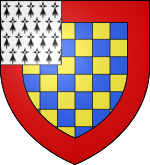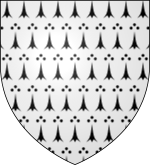List of rulers of Brittany
The partial
Kingdom of Armorica
- 409-421: Conan Mériadoc
- 421–434: St. Solomon I.
- 434-445: Grallon
- 445–464: Audren (Aldroenus)
- 464-490: Erech
- 490-509: Budic
- 513-545: Hoel I.
- 545-547: Hoel II.
- 547– ?: Canor (Canao)
- ? -594: Alain I.
- 594-615: Hoel III.
- 615: St. Judicaël († 650)
- 615-632: Solomon II.
- 632–634: St. Judicaël (again; † 650)
- 634– ?: Alain II, the Tall One
Kingdom of Dommonée
- St. Fracan
- Riwal I.
- Conan
- ? -513: Conothec
- 513-520: Riwal II.
- 520-530: Deroch
- 530-535: Riathen
- 535-540: Jonas
- 540; 554-580: St. Judual
- 580-605: St. Judhael
- 605–610: Judicaël († 652)
- 610-615: Haeloch
- 615–640: Judicaël (again; † 652)
Kingdom of Cornouailles (West Brittany)
- ? –505: Gradlon Mur, the great
- 505-515: Daniel Dremruz
- 515-524: Budic I.
- 524-531: St. Meliau
- 531-538: St. Melar
- 538-570: Budic II.
- 570-570: Teudric
- 570-577: St. Constantine
- 577– ?: Teudric (again)
Kingdom of Vannes
- ? -550: Werech I.
- 550-560: Canao I. (Canober)
- 560-577: Rachiau
Kingdom of Brittany
In the 9th century the country came under the influence of the neighboring Frankish empire , Emperor Ludwig the Pious had appointed the Breton petty king Nominoë as ducatus ipsius gentis (prince of his own tribe) of the Bretons in 831 . His successors emancipated themselves from Frankish rule and also accepted the title of king. However, a chronic lack of dynastic continuity with accompanying power struggles among each other prevented the development of a stable central power among the Bretons for a long time. During the 9th and 10th centuries, the country was regularly attacked by the Normans .
| Surname | Reign | relationship |
|---|---|---|
| Nominoë | 830-851 | |
| Erispoë (851 king) | 851-857 | Son of his predecessor |
| Solomon (868 king) | 857-874 | Nephew of Nominoë |
|
Pascweten Gurvant |
874-876 874-876 |
Son -in-law of Solomon -in-law of Erispoë |
|
Judicaël Alain I the Great |
876-888 876-907 |
Son of Gurvant brother of Pascweten |
| Gourmaëlon | 907-913 |
The Loire-Normans under Ragenold / Rögnvald, Felecan and Incon exploited the collapse of order following the death of King Alain the Great to conquer Nantes in 919. The Norman Duke Wilhelm Long Sword sometimes called himself "Duke of the Normans and Bretons".
Duchy of Brittany
In 937 the exile Alain Schiefbart returned to Brittany with the support of the Anglo-Saxon King Æthelstan , expelled the Normans from Nantes and assumed the title of duke ( Dux ). He is considered to be the founder of the high medieval duchy of Brittany, which largely corresponded in its scope to today's French region of Brittany .
At the beginning of the 13th century the dukes approached France, but took advantage of France's weakness in the Hundred Years War to secure a largely autonomous position. Despite the interruption by the War of the Breton Succession (1341-1364), the last dukes from the Dreux family were able to develop Brittany into a united principality with a strong central government. With the marriage of the last duchess to the French royal family, Brittany, as one of the last great feudal territories of the Middle Ages, was united with the crown domain at the beginning of the 16th century .
| Surname | Reign | relationship |
|---|---|---|
| House Nantes | ||
| Alain II wrybeard | 937-952 | Grandson of Alain I the Great |
| Drogo | 952-958 | Son of his predecessor |
| Hoël I. | 958-979 | Brother of his predecessor |
| Guérech | 979-988 | Brother of his predecessor |
| Alain | 988-990 | Son of his predecessor |
Conan the Crooked eliminated the House of Nantes in 990 and rose to become Duke. His defeat in the second Battle of Conquereuil led to a lasting weakening of the ducal power. Duke Alain III. recognized the Duke of Normandy as a feudal lord.
| Surname | Reign | relationship |
|---|---|---|
| House of Rennes | ||
| Conan I. the crooked | 990-992 | Descendant of Gurvants von Rennes |
| Gottfried I. | 992-1008 | Son of his predecessor |
| Alain III. | 1008-1040 | Son of his predecessor |
| Conan II. | 1040-1066 | Son of his predecessor |
| Hawisa | 1066-1072 | Sister of her predecessor |
| House Cornouaille | ||
| Hoël II. | 1066-1084 | Husband of Hawisa |
| Alain IV Fergant | 1084-1102 | Son of his predecessor |
| Conan III. the thick | 1102-1148 | Son of his predecessor |
| Hoël III. | 1148 | Son of his predecessor |
| Bertha | 1148-1158 | Sister of her predecessor |
| Eudon of Porhoët | 1148-1158 | Husband of Bertha |
Henry II Plantagenet , King of England and Duke of Normandy , ordered Conan IV to be appointed Duke in 1158 .
| Surname | Reign | relationship |
|---|---|---|
| Penthièvre house (younger line of the Rennes house) | ||
| Conan IV the little one | 1158-1166 | Descendant of Gottfried I. |
| Constance | 1166-1201 | Daughter of her predecessor |
Duke Conan IV. Was forced to abdicate by Heinrich II. Plantagenet in 1166 in favor of his son Gottfried II. During the time of the plantation rule, Brittany was assigned to the so-called Angivinian Empire , but Gottfried II paid homage to the French king for the first time.
| Surname | Reign | relationship |
|---|---|---|
| House Plantagenet | ||
| Gottfried II. | 1169-1186 | first husband of Konstanze |
| Arthur I. | 1196-1203 | Son of his predecessor |
| House of Thouars | ||
| Guido von Thouars | 1203-1206, 1207-1213 | third husband of Konstanze |
| Alix | 1203-1221 | Daughter of her predecessor |
In 1206, under pressure from King Philip II of France , Guido von Thouars had to give up the duchy, but remained regent for his daughter. After his death in 1213, the king ordered the marriage of the Duchess Alix with his distant cousin Peter Mauclerc , who was a descendant of King Ludwig VI. was the thick of France . However, the French crown refused to recognize Peter and his son as dukes. This was only given to Johann II in 1297.

| Surname | Reign | relationship |
|---|---|---|
| Dreux house | ||
| Peter I. Mauclerc | 1213-1221 | |
| Johann I the Red | 1221-1286 | Son of Alix and Peter Mauclerc |
| Johann II. | 1286-1305 | Son of his predecessor |
| Arthur II | 1305-1312 | Son of his predecessor |
| Johann III. the good | 1312-1341 | Son of his predecessor |
| Johann IV. | 1341-1345 | Brother of his predecessor |
| House of Châtillon | ||
| Charles of Blois | 1345-1364 | |
| Dreux house | ||
| Johann V the Conqueror | 1364-1399 | Son of Johann IV. |
| Johann VI. | 1399-1442 | Son of his predecessor |
| Franz I. | 1442-1450 | Son of his predecessor |
| Peter II | 1450-1457 | Brother of his predecessor |
| Arthur III from Richmond | 1457-1458 | Son of Johann V. |
| Francis II | 1458-1488 | Nephew of his predecessor |
| Anna | 1488-1514 | Daughter of her predecessor |
Duchess Anna successively married the French kings Charles VIII (1492) and Louis XII. (1499). In 1532, King Francis I of France , Duchess Claudia's husband , merged the duchy with the French crown following a resolution by the Breton Assembly of Estates in Vannes . The ducal dignity of Brittany was thus bound to the royal family under the law of inheritance to the exclusion of other pretenders, which ended the status of Brittany as a de facto autonomous principality.
| Surname | Reign | relationship |
|---|---|---|
| House of Valois-Orléans | ||
| Claudia | 1514-1524 | Daughter of her predecessor |
| House Valois-Angoulême | ||
| Francis III | 1524-1536 | Son of his predecessor |
|
Heinrich (King Henry II of France) |
1536-1547 | Brother of his predecessor |
Further use of the ducal title until the end of the monarchy
- Louis de Bourbon, duc de Bretagne (* 1704, † 1705)
- Dauphin Louis de Bourbon, duc de Bretagne (* 1707, † 1712): both sons of Dauphin Louis de Bourbon, duc de Bourgogne
- Dauphin Louis Joseph Xavier François de Bourbon , duc de Bretagne (* 1781, † 1789): son of King Louis XVI. from France
1973 Francisco Alfonso de Borbón (1972-1984) was awarded the title of "Duke of Brittany" by his grandfather Jaime de Borbón .
